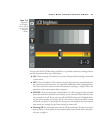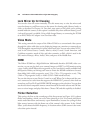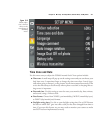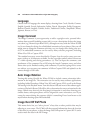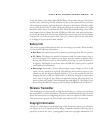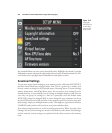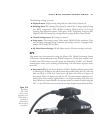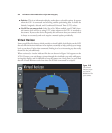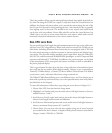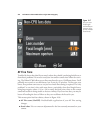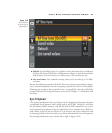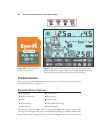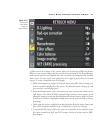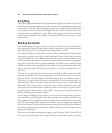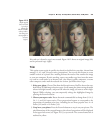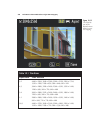That’s the problem. All my tripods and tripod heads already have bubble levels built in.
So, when I’m using the D7000 on a tripod, I really don’t need the Virtual Horizon. In
addition, the feature only shows when you’ve rotated the camera along the axis of the
lens. If you tilt it forward or back (pointing the lens a bit towards the sky or ground),
that angling won’t be detected. The bubble levels on my tripods and tripod heads
can do that, with no problems. I know folks who like and use the virtual horizon, but
I find it just a cute way to use the sensor built into your camera, which sends vertical/
horizontal orientation information to the various rotation features.
Non-CPU Lens Data
You can specify lens focal length data and maximum aperture for up to nine older man-
ual focus, non-CPU chipped lenses. When both values are entered, the D7000 can use
older lenses (including AI manual focus lenses) that are not equipped with a CPU chip
for color matrix metering to calculate exposure in Aperture-priority and Manual expo-
sure modes. The data also enables automatic power zoom when using the Nikon SB-
900, SB-700, and discontinued SB-800/SB-600 Speedlights, as well as improved flash
exposures and balanced iTTL fill-flash. In addition, the current aperture can be listed
in the monochrome LCD status panel and camera viewfinder, as well as embedded in
the photo playback display.
This is a great feature for those of us who have a large collection of manual focus lenses
that work just fine on modern Nikon digital cameras. I happen to use a manual focus
16mm f/3.5 Nikkor fisheye, a 55mm f/3.5 Micro-Nikkor, and an 85mm f/1.8 Nikkor
several times a week, with other older lenses seeing occasional use.
The Nikon D7000 allows defining up to nine different lenses, and I can choose any of
them with a quick trip to this menu entry (or to the equivalent menu item in My Menu,
described later in this chapter).
To enter this information, follow these steps using the screen shown in Figure 10.7:
1. Choose Non-CPU lens data from the Setup menu.
2. Highlight Lens Number and press the multi selector left/right buttons to choose a
number between 1 and 9.
3. Scroll down to Focal Length (mm) and use the multi selector left/right buttons to
choose a focal length between 6mm and 4000mm.
4. Scroll down to Maximum Aperture and use the multi selector left/right buttons to
choose a maximum f/stop between f/1.2 and f/22.
5. Choose Done. You can now select the lens number using any of several controls
you can define for the Fn button, or depth-of-field preview button as described in
Chapter 9 under CSM #f3, or CSM #f4.
Chapter 10 ■ Setup: The Setup Menu, Retouch Menu, and My Menu 323



